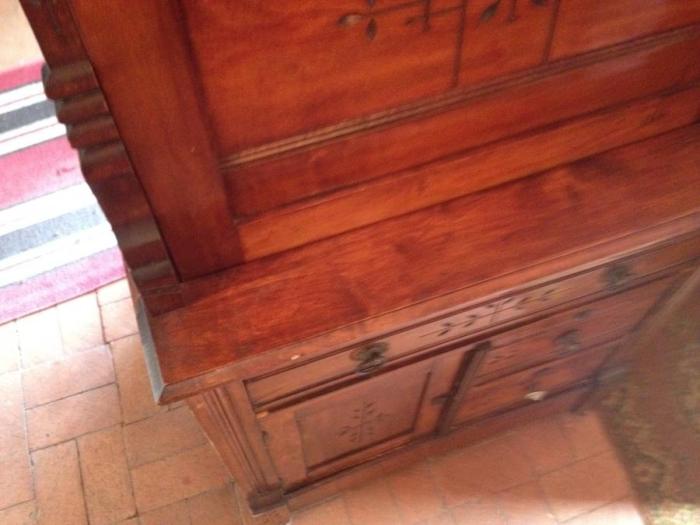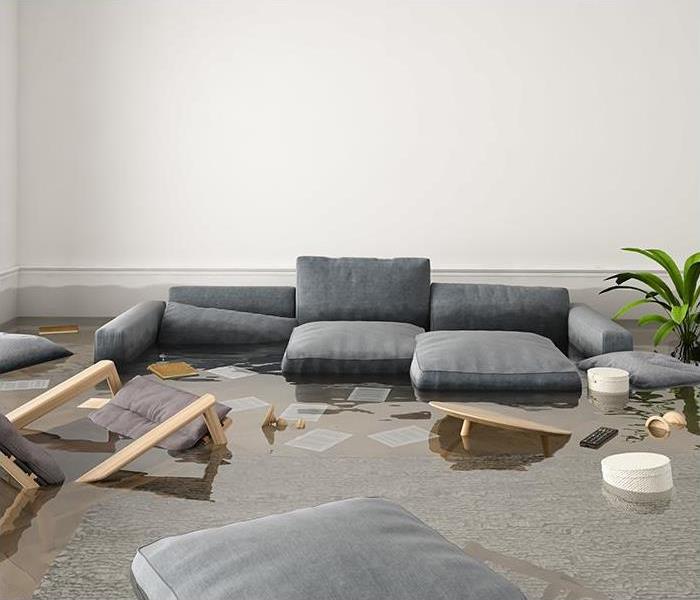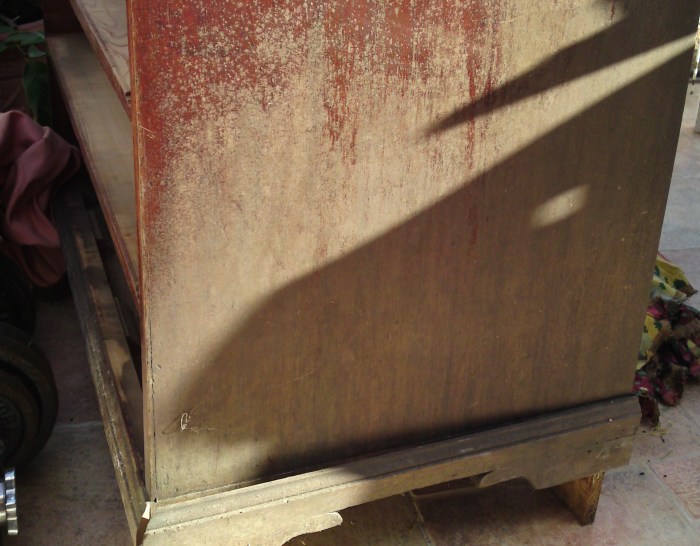Water damaged furniture can be a nightmare, but it doesn’t have to be. With the right knowledge and techniques, you can restore your furniture to its former glory and prevent future damage. In this guide, we’ll cover everything you need to know about water damaged furniture, from restoration to prevention and insurance.
Whether you’re dealing with a minor spill or a major flood, this guide will help you get your furniture back in shape and protect it from future water damage.
Restoration Process

Restoring water damaged furniture requires a systematic approach to assess the damage, determine if restoration is feasible, and apply appropriate repair and refinishing techniques.
Before initiating restoration, it’s crucial to assess the extent of water damage. Inspect the furniture for signs of swelling, warping, discoloration, or mold growth. If the damage is severe or affects structural components, professional restoration may be necessary.
Unfortunately, water damaged furniture can be a pain to deal with, but if you need to ship furniture across country, you can always rely on professional movers to handle the heavy lifting for you. Ship furniture across country with ease and peace of mind, knowing that your belongings are in good hands.
Even water damaged furniture can be restored to its former glory with the right care and attention.
Damage Assessment
- Examine the furniture for visible damage, including swelling, warping, discoloration, and mold growth.
- Check for loose joints, weakened glue bonds, and any signs of structural instability.
- Identify the type of water that caused the damage (e.g., clean water, salt water, sewage).
Repair Techniques
- Drying and Dehumidification:Remove excess moisture from the furniture using fans, dehumidifiers, or air conditioning.
- Re-gluing:Apply new glue to weakened joints and clamps to ensure a secure bond.
- Structural Repair:Replace or reinforce damaged structural components, such as legs, frames, or supports.
- Woodworking:Repair damaged wood using techniques like sanding, filling, and shaping.
Refinishing Techniques
- Stripping:Remove old finish from the furniture using chemical strippers or sanding.
- Sanding:Smooth and prepare the surface for refinishing by sanding with progressively finer grits.
- Staining:Apply stain to enhance the wood’s natural grain or color.
- Finishing:Protect and beautify the furniture with a clear finish, such as varnish, lacquer, or polyurethane.
Materials and Equipment
Water damage restoration requires specialized materials and equipment to effectively clean, dry, and repair affected surfaces. Understanding the functions and benefits of these materials and tools is crucial for a successful restoration process.
- Moisture Meters: These devices measure the moisture content of materials, indicating the extent of water damage and guiding the drying process.
- Dehumidifiers: These machines remove excess moisture from the air, creating a dry environment to prevent mold growth and further damage.
- Air Movers: These fans circulate air, speeding up the drying process and preventing musty odors.
- Extraction Equipment: Pumps and vacuums remove standing water from affected areas, minimizing damage.
- Cleaning Solutions: Specialized cleaning solutions are used to remove dirt, grime, and contaminants from damaged surfaces.
- Protective Gear: Gloves, masks, and goggles protect workers from exposure to hazardous materials during the restoration process.
Safety Precautions
Handling water-damaged materials and equipment requires strict adherence to safety protocols. Always wear appropriate protective gear, avoid contact with contaminated surfaces, and ensure proper ventilation to prevent exposure to mold spores or harmful chemicals.
- Electrical Safety: Inspect electrical equipment for damage before use. Never operate electrical appliances in standing water.
- Chemical Safety: Use cleaning solutions according to manufacturer’s instructions. Wear protective gear and avoid mixing chemicals.
- Mold Prevention: Promptly remove standing water and ventilate affected areas to prevent mold growth.
Prevention and Mitigation
Preventing water damage to furniture is crucial for preserving its longevity and aesthetic appeal. Regular maintenance and cleaning are essential. If water damage occurs, immediate action is vital to minimize its impact.
Regular Maintenance and Cleaning
- Use coasters and placemats to protect surfaces from spills.
- Clean spills immediately with a soft, absorbent cloth.
- Vacuum or brush furniture regularly to remove dust and dirt.
- Periodically apply furniture polish to protect surfaces from moisture.
Mitigating Water Damage
- Act immediately:Blot excess water with a clean cloth and open windows for ventilation.
- Assess the damage:Determine the extent of the damage and identify the source of the water.
- Contact a professional:For significant damage, consult a furniture restoration specialist.
- Dry the furniture:Use fans, dehumidifiers, or professional drying services to remove moisture.
- Prevent mold growth:Keep the furniture dry and apply mold-inhibiting solutions as necessary.
Insurance and Claims
Insurance plays a crucial role in mitigating the financial impact of water-damaged furniture. Homeowners or renters insurance policies typically cover damages caused by unexpected events like floods, storms, or burst pipes. Understanding your policy and filing a claim promptly is essential to maximize coverage.
Filing a Claim
When water damage occurs, contact your insurance company immediately. They will guide you through the claims process, which typically involves:
- Documenting the damage with photos and videos
- Providing a detailed inventory of damaged items
- Obtaining estimates for repairs or replacements
Documentation and Evidence
To support your claim, gather as much documentation as possible, including:
- Proof of ownership (receipts, appraisals)
- Evidence of the cause of damage (weather reports, plumber’s reports)
- Repair estimates or replacement costs
Working with Insurance Companies
Communicate clearly with your insurance adjuster. Provide accurate information, respond promptly to requests, and keep records of all interactions. It’s advisable to consult with an insurance professional if you have any questions or concerns about the claims process.
DIY vs. Professional Restoration
When it comes to water damage restoration, you have two options: do it yourself (DIY) or hire a professional. Both options have their own advantages and disadvantages, so it’s important to weigh the pros and cons before making a decision.
When water damage strikes, don’t let your furniture suffer. Haverty Furniture Companies Inc. , a leading provider of quality furniture, offers expert restoration services to bring your water-damaged pieces back to life. Their skilled craftsmen use advanced techniques to restore the original beauty and functionality of your furniture, ensuring it will continue to grace your home for years to come.
Advantages of DIY Restoration
- Cost-effective:DIY restoration can save you money compared to hiring a professional. However, it’s important to factor in the cost of materials and equipment, as well as the time and effort required.
- Convenient:DIY restoration allows you to work at your own pace and on your own schedule. This can be beneficial if you have a busy lifestyle or if you’re on a tight budget.
- Control:DIY restoration gives you complete control over the process. You can choose the materials and methods you use, and you can work at your own pace.
Disadvantages of DIY Restoration, Water damaged furniture
- Time-consuming:DIY restoration can be a time-consuming process, especially if you’re not familiar with the work involved. It’s important to set realistic expectations and allow yourself plenty of time to complete the project.
- Difficult:DIY restoration can be difficult, especially if you’re not experienced in working with water damage. It’s important to follow the instructions carefully and take all necessary safety precautions.
- Risk of further damage:If you’re not careful, DIY restoration can actually cause further damage to your property. It’s important to know your limits and seek professional help if you’re not sure how to proceed.
Advantages of Professional Restoration
- Experience and expertise:Professional restorers have the experience and expertise to handle water damage effectively. They know how to assess the damage, choose the right materials and methods, and restore your property to its pre-damage condition.
- Equipment and resources:Professional restorers have access to specialized equipment and resources that can help them to quickly and efficiently restore your property. This can save you time and money in the long run.
- Peace of mind:Hiring a professional restorer can give you peace of mind knowing that your property is in good hands. You can rest assured that the job will be done right and that your property will be restored to its pre-damage condition.
Disadvantages of Professional Restoration
- Cost:Hiring a professional restorer can be more expensive than DIY restoration. However, it’s important to factor in the cost of materials and equipment, as well as the time and effort required to do the job yourself.
- Scheduling:Professional restorers may have a busy schedule, so it’s important to book their services in advance. This can be a problem if you need the work done quickly.
- Control:When you hire a professional restorer, you give up some control over the process. You may not be able to choose the materials and methods used, and you may have to work around the restorer’s schedule.
When to Hire a Professional
There are some cases where it’s best to hire a professional restorer. These include:
- The damage is extensive:If the water damage is extensive, it’s best to hire a professional restorer to ensure that the job is done right.
- The damage is in a difficult-to-reach area:If the water damage is in a difficult-to-reach area, it’s best to hire a professional restorer who has the equipment and expertise to access the area.
- You don’t have the time or experience:If you don’t have the time or experience to do the job yourself, it’s best to hire a professional restorer.
Health and Safety

Water-damaged furniture poses potential health risks that should not be ignored. Understanding these risks and taking appropriate precautions is crucial for your safety and well-being.
Mold growth is a common concern with water-damaged furniture. Mold spores can trigger allergic reactions, asthma attacks, and respiratory issues. Prolonged exposure can lead to more severe health problems.
Water damaged furniture can be a real eyesore, but it doesn’t have to be a permanent problem. With the right products and techniques, you can restore your furniture to its former glory. One great option for water damaged furniture is matrix furniture . Matrix furniture is made from a durable, water-resistant material that can withstand even the most severe water damage.
Plus, it’s easy to clean and maintain, so you can keep your furniture looking its best for years to come.
Protection Measures
- Wear protective gear such as gloves, masks, and eye protection when handling water-damaged furniture.
- Ensure proper ventilation by opening windows and doors, or using fans to circulate air.
- If mold is present, do not attempt to clean it yourself. Contact a professional mold remediation company.
Last Word: Water Damaged Furniture

Water damaged furniture can be a major headache, but it doesn’t have to be a disaster. By following the tips in this guide, you can restore your furniture to its former glory and prevent future damage. So don’t despair if your furniture gets wet.
With a little care and attention, you can bring it back to life.
Expert Answers
How can I tell if my furniture is water damaged?
There are a few signs that can indicate water damage, including:
- Swelling or warping
- Discoloration
- Mold or mildew
- Musty odor
Can I restore water damaged furniture myself?
It depends on the extent of the damage. If the damage is minor, you may be able to restore the furniture yourself using a few simple techniques. However, if the damage is more severe, it’s best to consult with a professional.
What should I do if my furniture is water damaged?
If your furniture is water damaged, the first thing you should do is blot up as much water as possible using a clean cloth or sponge. Then, you should open up the furniture to allow it to dry completely. Once the furniture is dry, you can assess the damage and determine if it can be restored.